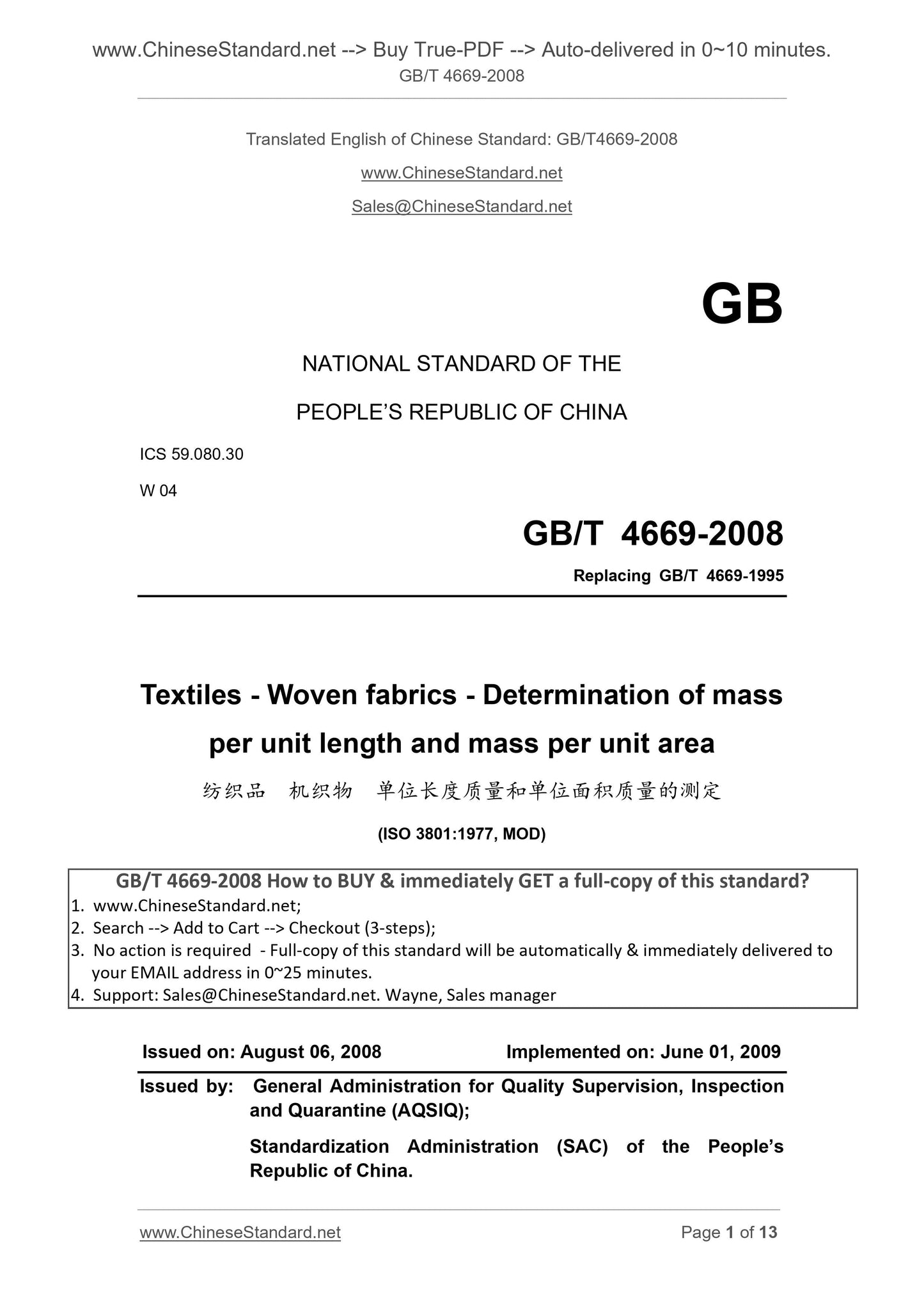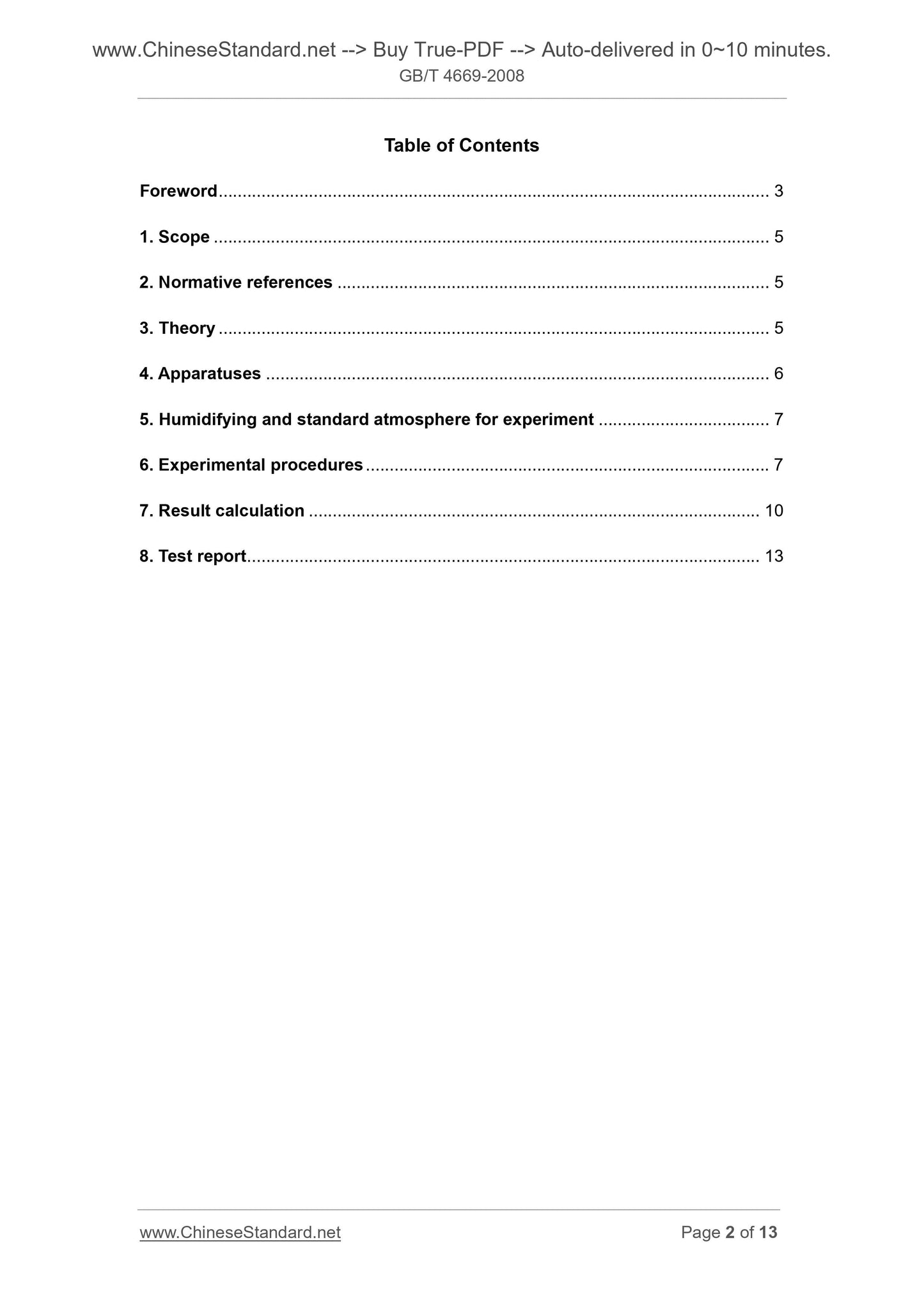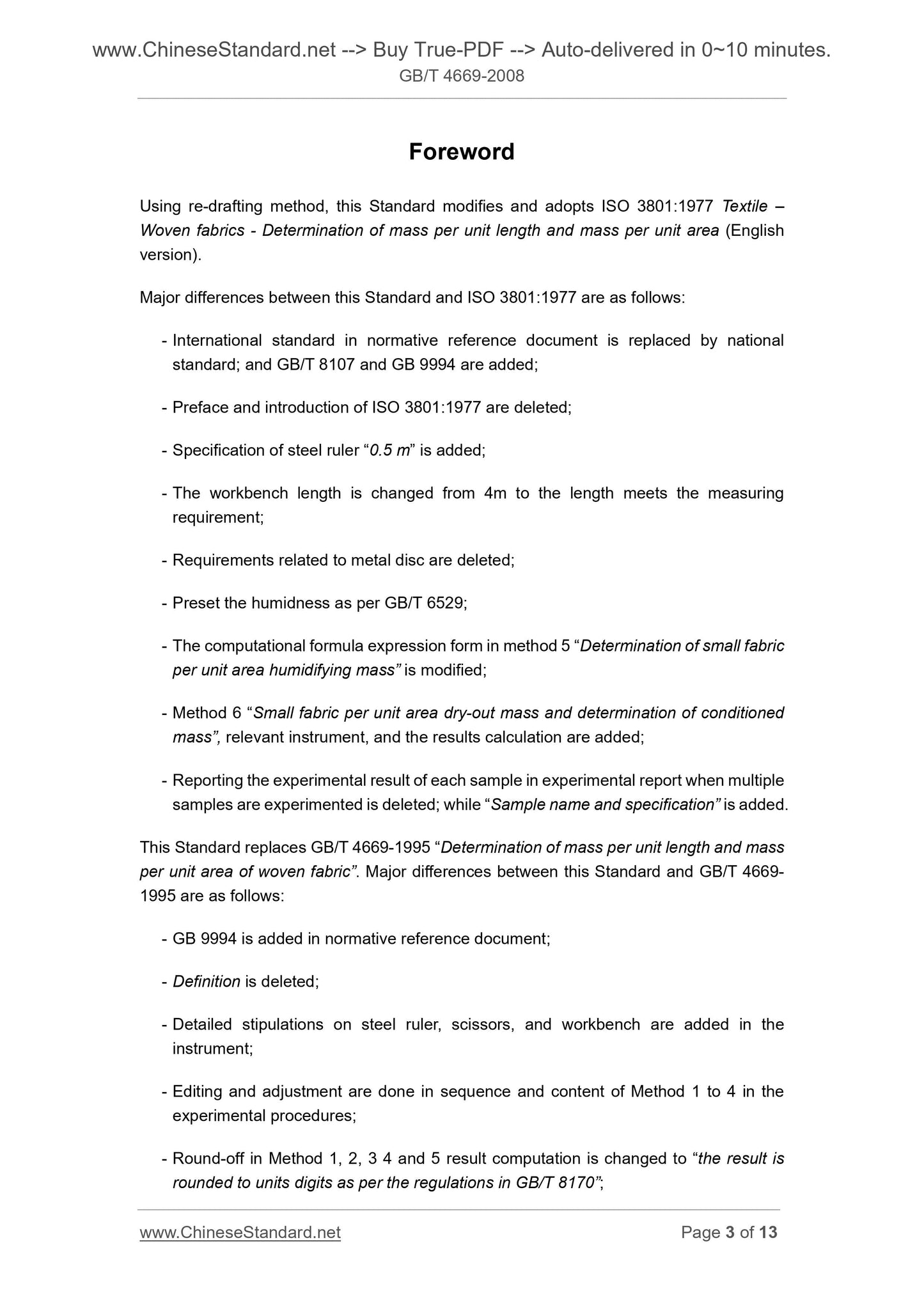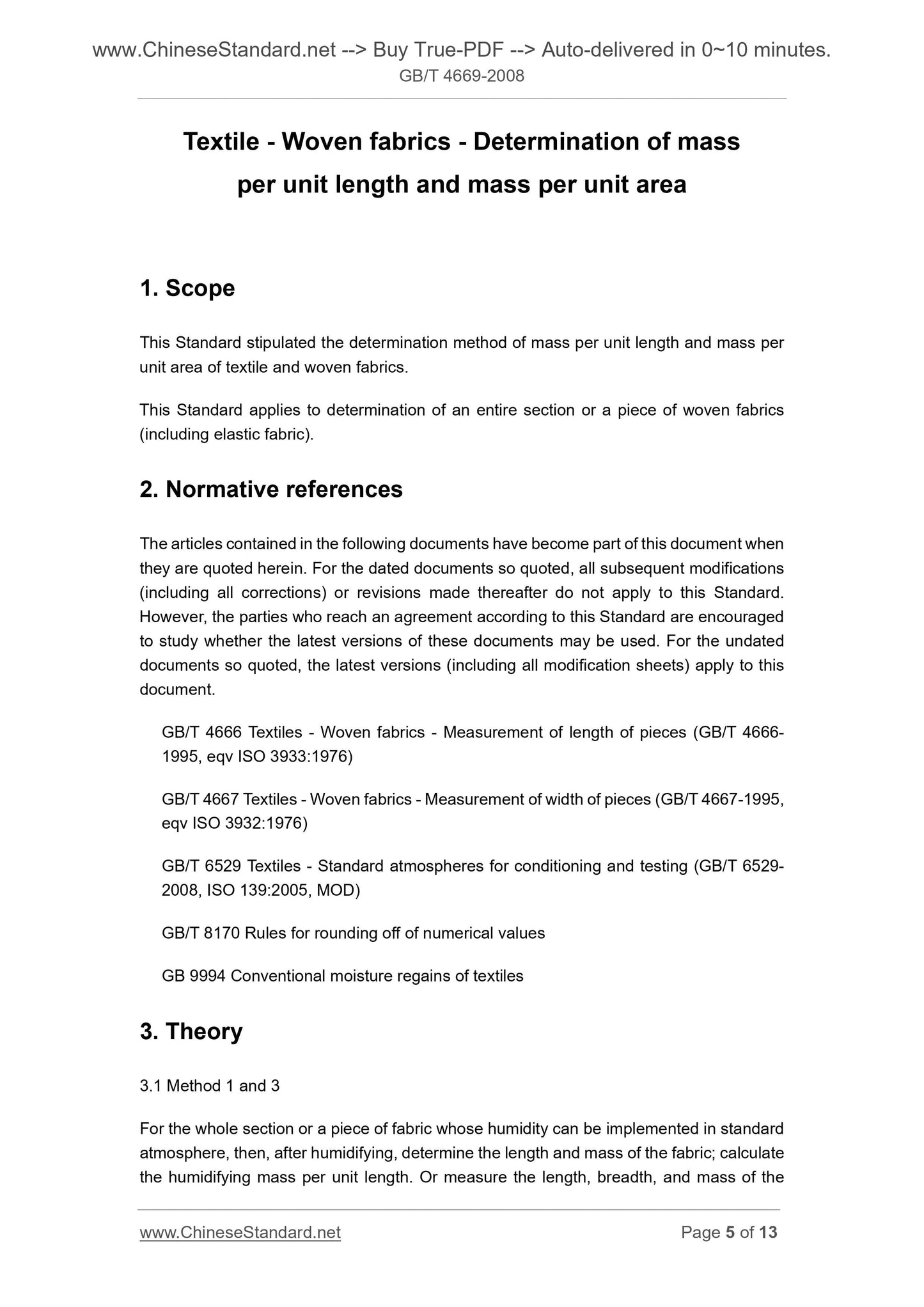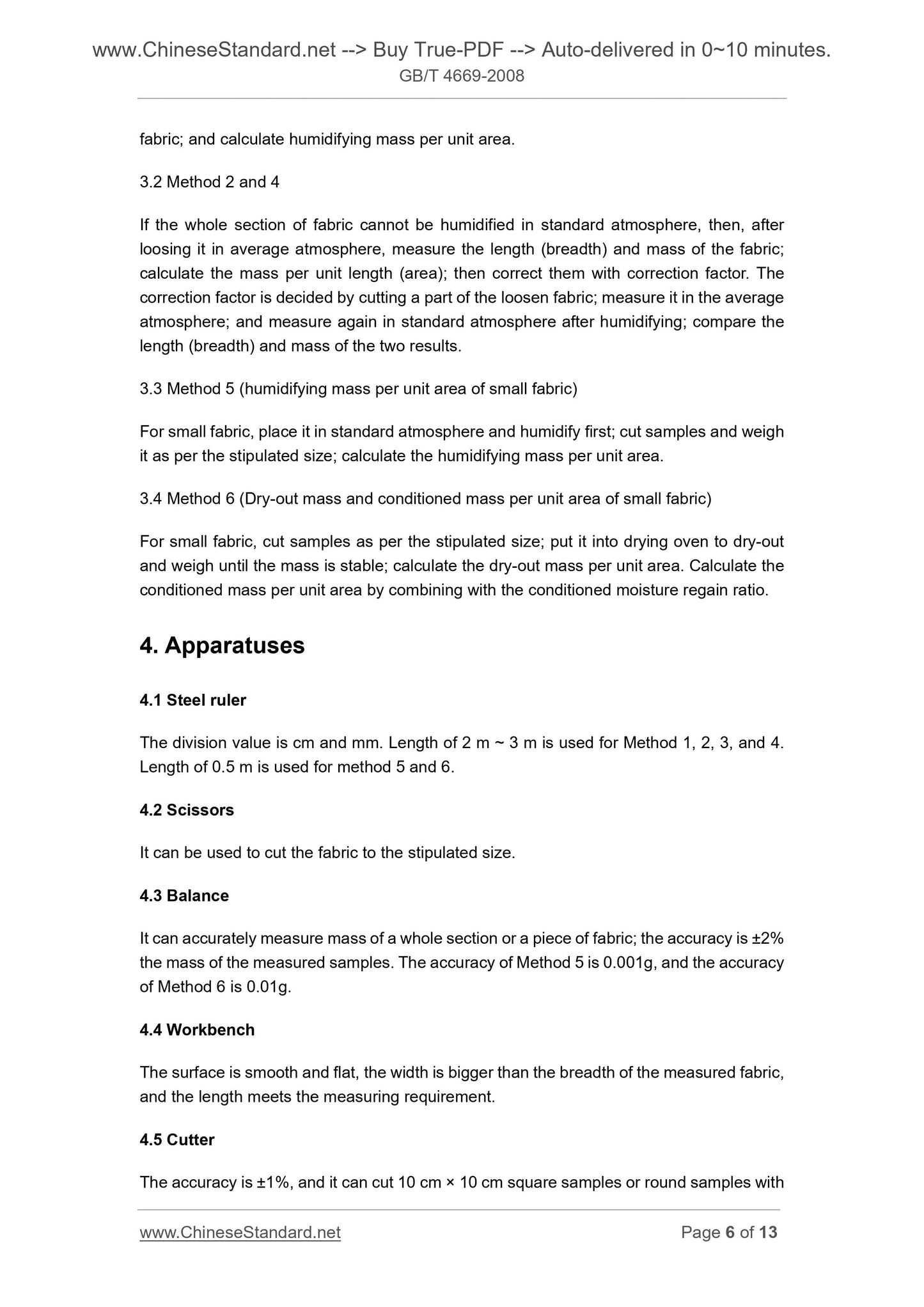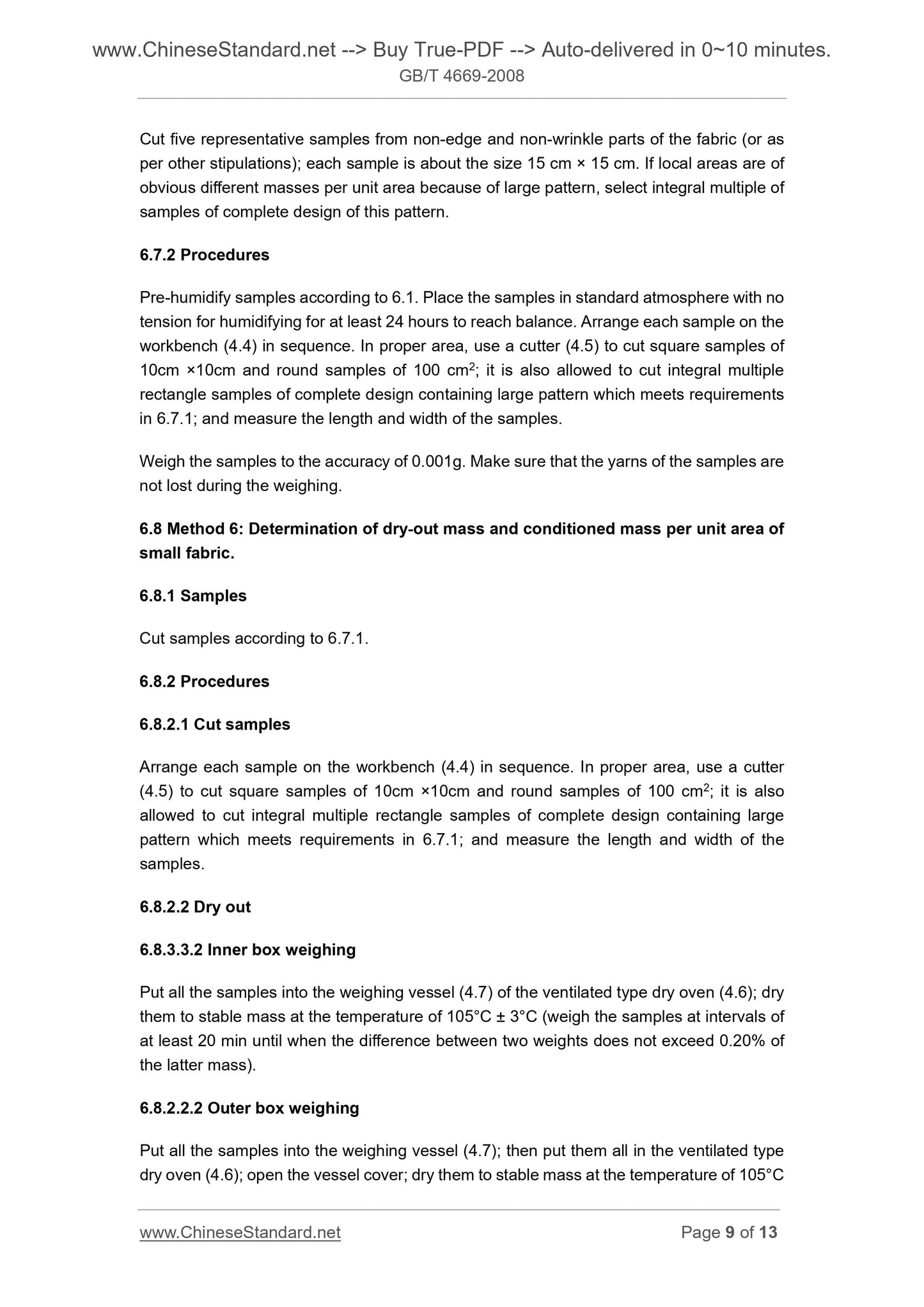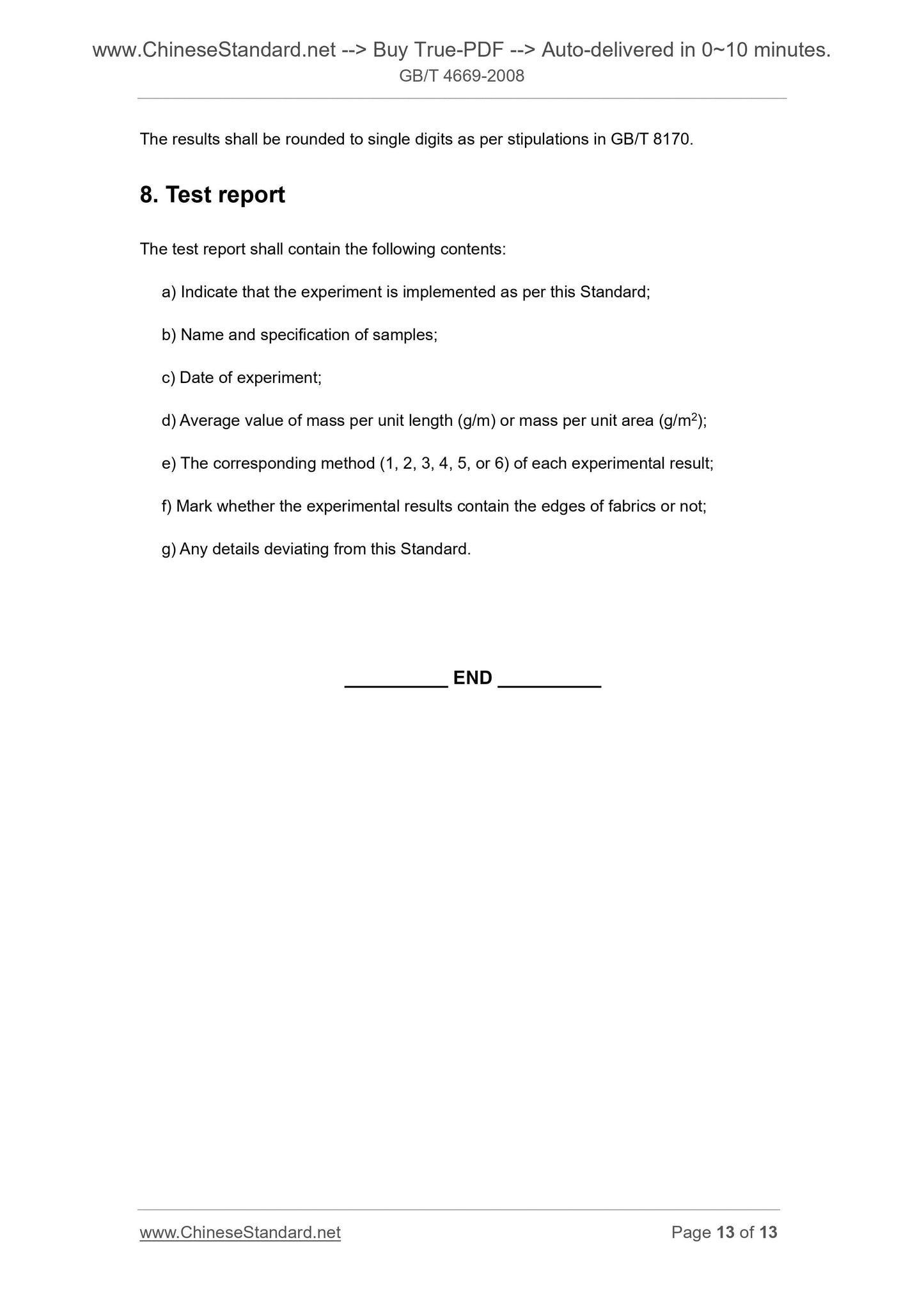1
/
of
7
www.ChineseStandard.us -- Field Test Asia Pte. Ltd.
GB/T 4669-2008 English PDF (GB/T4669-2008)
GB/T 4669-2008 English PDF (GB/T4669-2008)
Regular price
$85.00
Regular price
Sale price
$85.00
Unit price
/
per
Shipping calculated at checkout.
Couldn't load pickup availability
GB/T 4669-2008: Textiles -- Woven fabrics -- Determination of mass per unit length and mass per unit area
Delivery: 9 seconds. Download (& Email) true-PDF + Invoice.
Get Quotation: Click GB/T 4669-2008 (Self-service in 1-minute)
Historical versions (Master-website): GB/T 4669-2008
Preview True-PDF (Reload/Scroll-down if blank)
GB/T 4669-2008
GB
NATIONAL STANDARD OF THE
PEOPLE’S REPUBLIC OF CHINA
ICS 59.080.30
W 04
Replacing GB/T 4669-1995
Textiles - Woven fabrics - Determination of mass
per unit length and mass per unit area
(ISO 3801.1977, MOD)
ISSUED ON. AUGUST 06, 2008
IMPLEMENTED ON. JUNE 01, 2009
Issued by. General Administration for Quality Supervision, Inspection
and Quarantine (AQSIQ);
Standardization Administration (SAC) of the People’s
Republic of China.
Table of Contents
Foreword ... 3
1. Scope ... 5
2. Normative references ... 5
3. Theory ... 5
4. Apparatuses ... 6
5. Humidifying and standard atmosphere for experiment ... 7
6. Experimental procedures ... 7
7. Result calculation ... 10
8. Test report ... 13
Foreword
Using re-drafting method, this Standard modifies and adopts ISO 3801.1977 Textile –
Woven fabrics - Determination of mass per unit length and mass per unit area (English
version).
Major differences between this Standard and ISO 3801.1977 are as follows.
- International standard in normative reference document is replaced by national
standard; and GB/T 8107 and GB 9994 are added;
- Preface and introduction of ISO 3801.1977 are deleted;
- Specification of steel ruler “0.5 m” is added;
- The workbench length is changed from 4m to the length meets the measuring
requirement;
- Requirements related to metal disc are deleted;
- Preset the humidness as per GB/T 6529;
- The computational formula expression form in method 5 “Determination of small fabric
per unit area humidifying mass” is modified;
- Method 6 “Small fabric per unit area dry-out mass and determination of conditioned
mass”, relevant instrument, and the results calculation are added;
- Reporting the experimental result of each sample in experimental report when multiple
samples are experimented is deleted; while “Sample name and specification” is added.
This Standard replaces GB/T 4669-1995 “Determination of mass per unit length and mass
per unit area of woven fabric”. Major differences between this Standard and GB/T 4669-
1995 are as follows.
- GB 9994 is added in normative reference document;
- Definition is deleted;
- Detailed stipulations on steel ruler, scissors, and workbench are added in the
instrument;
- Editing and adjustment are done in sequence and content of Method 1 to 4 in the
experimental procedures;
- Round-off in Method 1, 2, 3 4 and 5 result computation is changed to “the result is
rounded to units digits as per the regulations in GB/T 8170”;
Textile - Woven fabrics - Determination of mass
per unit length and mass per unit area
1. Scope
This Standard stipulated the determination method of mass per unit length and mass per
unit area of textile and woven fabrics.
This Standard applies to determination of an entire section or a piece of woven fabrics
(including elastic fabric).
2. Normative references
The articles contained in the following documents have become part of this document when
they are quoted herein. For the dated documents so quoted, all subsequent modifications
(including all corrections) or revisions made thereafter do not apply to this Standard.
However, the parties who reach an agreement according to this Standard are encouraged
to study whether the latest versions of these documents may be used. For the undated
documents so quoted, the latest versions (including all modification sheets) apply to this
document.
GB/T 4666 Textiles - Woven fabrics - Measurement of length of pieces (GB/T 4666-
1995, eqv ISO 3933.1976)
GB/T 4667 Textiles - Woven fabrics - Measurement of width of pieces (GB/T 4667-1995,
eqv ISO 3932.1976)
GB/T 6529 Textiles - Standard atmospheres for conditioning and testing (GB/T 6529-
2008, ISO 139.2005, MOD)
GB/T 8170 Rules for rounding off of numerical values
GB 9994 Conventional moisture regains of textiles
3. Theory
3.1 Method 1 and 3
For the whole section or a piece of fabric whose humidity can be implemented in standard
atmosphere, then, after humidifying, determine the length and mass of the fabric; calculate
the humidifying mass per unit length. Or measure the length, breadth, and mass of the
fabric; and calculate humidifying mass per unit area.
3.2 Method 2 and 4
If the whole section of fabric cannot be humidified in standard atmosphere, then, after
loosing it in average atmosphere, measure the length (breadth) and mass of the fabric;
calculate the mass per unit length (area); then correct them with correction factor. The
correction factor is decided by cutting a part of the loosen fabric; measure it in the average
atmosphere; and measure again in standard atmosphere after humidifying; compare the
length (breadth) and mass of the two results.
3.3 Method 5 (humidifying mass per unit area of small fabric)
For small fabric, place it in standard atmosphere and humidify first; cut samples and weigh
it as per the stipulated size; calculate the humidifying mass per unit area.
3.4 Method 6 (Dry-out mass and conditioned mass per unit area of small fabric)
For small fabric, cut samples as per the stipulated size; put it into drying oven to dry-out
and weigh until the mass is stable; calculate the dry-out mass per unit area. Calculate the
conditioned mass per unit area by combining with the conditioned moisture regain ratio.
4. Apparatuses
4.1 Steel ruler
The division value is cm and mm. Length of 2 m ~ 3 m is used for Method 1, 2, 3, and 4.
Length of 0.5 m is used for method 5 and 6.
4.2 Scissors
It can be used to cut the fabric to the stipulated size.
4.3 Balance
It can accurately measure mass of a whole section or a piece of fabric; the accuracy is ±2%
the mass of the measured samples. The accuracy of Method 5 is 0.001g, and the accuracy
of Method 6 is 0.01g.
4.4 Workbench
The surface is smooth and flat, the width is bigger than the breadth of the measured fabric,
and the length meets the measuring requirement.
4.5 Cutter
The accuracy is ±1%, and it can cut 10 cm × 10 cm square samples or round samples with
Cut five representative samples from non-edge and non-wrinkle parts of the fabric (or as
per other stipulations); each sample is about the size 15 cm × 15 cm. If local areas are of
obvious different masses per unit area because of large pattern, select integral multiple of
samples of complete design of this pattern.
6.7.2 Procedures
Pre-humidify samples according to 6.1. Place the samples in standard atmosphere with no
tension for humidifying for at least 24 hours to reach balance. Arrange each sample on the
workbench (4.4) in sequence. In proper area, use a cutter (4.5) to cut square samples of
10cm ×10cm and round samples of 100 cm2; it is also allowed to cut integral multiple
rectangle samples of complete design containing large pattern which meets requirements
in 6.7.1; and measure the length and width of the samples.
Weigh the samples to the accuracy of 0.001g. Make sure that the yarns of the samples are
not lost during the weighing.
6.8 Method 6. Determination of dry-out mass and conditioned mass per unit area of
small fabric.
6.8.1 Samples
Cut samples according to 6.7.1.
6.8.2 Procedures
6.8.2.1 Cut samples
Arrange each sample on the workbench (4.4) in sequence. In proper area, use a cutter
(4.5) to cut square samples of 10cm ×10cm and round samples of 100 cm2; it is also
allowed to cut integral multiple rectangle samples of complete design containing large
pattern which meets requirements in 6.7.1; and measure the length and width of the
samples.
6.8.2.2 Dry out
6.8.3.3.2 Inner box weighing
Put all the samples into the weighing vessel (4.7) of the ventilated type dry oven (4.6); dry
them to stable mass at the temperature of 105°C ± 3°C (weigh the samples at intervals of
at least 20 min until when the difference between two weights does not exceed 0.20% of
the latter mass).
6.8.2.2.2 Outer box weighing
Put all the samples into the weighing vessel (4.7); then put them all in the ventilated type
dry oven (4.6); open the vessel cover; dry them to stable mass at the temperature of 105°C
The results shall be rounded to single digits as per stipulations in GB/T 8170.
8. Test report
The test report shall contain the following contents.
a) Indicate that the experiment is implemented as per this Standard;
b) Name and specification of samples;
c) Date of experiment;
d) Average value of mass per unit length (g/m) or mass per unit area (g/m2);
e) The corresponding method (1, 2, 3, 4, 5, or 6) of each experimental result;
f) Mark whether the experimental results contain the edges of fabrics or not;
g) Any details deviating from this Standard.
GB/T 4669-2008
GB
NATIONAL STANDARD OF THE
PEOPLE’S REPUBLIC OF CHINA
ICS 59.080.30
W 04
Replacing GB/T 4669-1995
Textiles - Woven fabrics - Determination of mass
per unit length and mass per unit area
(ISO 3801.1977, MOD)
ISSUED ON. AUGUST 06, 2008
IMPLEMENTED ON. JUNE 01, 2009
Issued by. General Administration for Quality Supervision, Inspection
and Quarantine (AQSIQ);
Standardization Administration (SAC) of the People’s
Republic of China.
Table of Contents
Foreword ... 3
1. Scope ... 5
2. Normative references ... 5
3. Theory ... 5
4. Apparatuses ... 6
5. Humidifying and standard atmosphere for experiment ... 7
6. Experimental procedures ... 7
7. Result calculation ... 10
8. Test report ... 13
Foreword
Using re-drafting method, this Standard modifies and adopts ISO 3801.1977 Textile –
Woven fabrics - Determination of mass per unit length and mass per unit area (English
version).
Major differences between this Standard and ISO 3801.1977 are as follows.
- International standard in normative reference document is replaced by national
standard; and GB/T 8107 and GB 9994 are added;
- Preface and introduction of ISO 3801.1977 are deleted;
- Specification of steel ruler “0.5 m” is added;
- The workbench length is changed from 4m to the length meets the measuring
requirement;
- Requirements related to metal disc are deleted;
- Preset the humidness as per GB/T 6529;
- The computational formula expression form in method 5 “Determination of small fabric
per unit area humidifying mass” is modified;
- Method 6 “Small fabric per unit area dry-out mass and determination of conditioned
mass”, relevant instrument, and the results calculation are added;
- Reporting the experimental result of each sample in experimental report when multiple
samples are experimented is deleted; while “Sample name and specification” is added.
This Standard replaces GB/T 4669-1995 “Determination of mass per unit length and mass
per unit area of woven fabric”. Major differences between this Standard and GB/T 4669-
1995 are as follows.
- GB 9994 is added in normative reference document;
- Definition is deleted;
- Detailed stipulations on steel ruler, scissors, and workbench are added in the
instrument;
- Editing and adjustment are done in sequence and content of Method 1 to 4 in the
experimental procedures;
- Round-off in Method 1, 2, 3 4 and 5 result computation is changed to “the result is
rounded to units digits as per the regulations in GB/T 8170”;
Textile - Woven fabrics - Determination of mass
per unit length and mass per unit area
1. Scope
This Standard stipulated the determination method of mass per unit length and mass per
unit area of textile and woven fabrics.
This Standard applies to determination of an entire section or a piece of woven fabrics
(including elastic fabric).
2. Normative references
The articles contained in the following documents have become part of this document when
they are quoted herein. For the dated documents so quoted, all subsequent modifications
(including all corrections) or revisions made thereafter do not apply to this Standard.
However, the parties who reach an agreement according to this Standard are encouraged
to study whether the latest versions of these documents may be used. For the undated
documents so quoted, the latest versions (including all modification sheets) apply to this
document.
GB/T 4666 Textiles - Woven fabrics - Measurement of length of pieces (GB/T 4666-
1995, eqv ISO 3933.1976)
GB/T 4667 Textiles - Woven fabrics - Measurement of width of pieces (GB/T 4667-1995,
eqv ISO 3932.1976)
GB/T 6529 Textiles - Standard atmospheres for conditioning and testing (GB/T 6529-
2008, ISO 139.2005, MOD)
GB/T 8170 Rules for rounding off of numerical values
GB 9994 Conventional moisture regains of textiles
3. Theory
3.1 Method 1 and 3
For the whole section or a piece of fabric whose humidity can be implemented in standard
atmosphere, then, after humidifying, determine the length and mass of the fabric; calculate
the humidifying mass per unit length. Or measure the length, breadth, and mass of the
fabric; and calculate humidifying mass per unit area.
3.2 Method 2 and 4
If the whole section of fabric cannot be humidified in standard atmosphere, then, after
loosing it in average atmosphere, measure the length (breadth) and mass of the fabric;
calculate the mass per unit length (area); then correct them with correction factor. The
correction factor is decided by cutting a part of the loosen fabric; measure it in the average
atmosphere; and measure again in standard atmosphere after humidifying; compare the
length (breadth) and mass of the two results.
3.3 Method 5 (humidifying mass per unit area of small fabric)
For small fabric, place it in standard atmosphere and humidify first; cut samples and weigh
it as per the stipulated size; calculate the humidifying mass per unit area.
3.4 Method 6 (Dry-out mass and conditioned mass per unit area of small fabric)
For small fabric, cut samples as per the stipulated size; put it into drying oven to dry-out
and weigh until the mass is stable; calculate the dry-out mass per unit area. Calculate the
conditioned mass per unit area by combining with the conditioned moisture...
Delivery: 9 seconds. Download (& Email) true-PDF + Invoice.
Get Quotation: Click GB/T 4669-2008 (Self-service in 1-minute)
Historical versions (Master-website): GB/T 4669-2008
Preview True-PDF (Reload/Scroll-down if blank)
GB/T 4669-2008
GB
NATIONAL STANDARD OF THE
PEOPLE’S REPUBLIC OF CHINA
ICS 59.080.30
W 04
Replacing GB/T 4669-1995
Textiles - Woven fabrics - Determination of mass
per unit length and mass per unit area
(ISO 3801.1977, MOD)
ISSUED ON. AUGUST 06, 2008
IMPLEMENTED ON. JUNE 01, 2009
Issued by. General Administration for Quality Supervision, Inspection
and Quarantine (AQSIQ);
Standardization Administration (SAC) of the People’s
Republic of China.
Table of Contents
Foreword ... 3
1. Scope ... 5
2. Normative references ... 5
3. Theory ... 5
4. Apparatuses ... 6
5. Humidifying and standard atmosphere for experiment ... 7
6. Experimental procedures ... 7
7. Result calculation ... 10
8. Test report ... 13
Foreword
Using re-drafting method, this Standard modifies and adopts ISO 3801.1977 Textile –
Woven fabrics - Determination of mass per unit length and mass per unit area (English
version).
Major differences between this Standard and ISO 3801.1977 are as follows.
- International standard in normative reference document is replaced by national
standard; and GB/T 8107 and GB 9994 are added;
- Preface and introduction of ISO 3801.1977 are deleted;
- Specification of steel ruler “0.5 m” is added;
- The workbench length is changed from 4m to the length meets the measuring
requirement;
- Requirements related to metal disc are deleted;
- Preset the humidness as per GB/T 6529;
- The computational formula expression form in method 5 “Determination of small fabric
per unit area humidifying mass” is modified;
- Method 6 “Small fabric per unit area dry-out mass and determination of conditioned
mass”, relevant instrument, and the results calculation are added;
- Reporting the experimental result of each sample in experimental report when multiple
samples are experimented is deleted; while “Sample name and specification” is added.
This Standard replaces GB/T 4669-1995 “Determination of mass per unit length and mass
per unit area of woven fabric”. Major differences between this Standard and GB/T 4669-
1995 are as follows.
- GB 9994 is added in normative reference document;
- Definition is deleted;
- Detailed stipulations on steel ruler, scissors, and workbench are added in the
instrument;
- Editing and adjustment are done in sequence and content of Method 1 to 4 in the
experimental procedures;
- Round-off in Method 1, 2, 3 4 and 5 result computation is changed to “the result is
rounded to units digits as per the regulations in GB/T 8170”;
Textile - Woven fabrics - Determination of mass
per unit length and mass per unit area
1. Scope
This Standard stipulated the determination method of mass per unit length and mass per
unit area of textile and woven fabrics.
This Standard applies to determination of an entire section or a piece of woven fabrics
(including elastic fabric).
2. Normative references
The articles contained in the following documents have become part of this document when
they are quoted herein. For the dated documents so quoted, all subsequent modifications
(including all corrections) or revisions made thereafter do not apply to this Standard.
However, the parties who reach an agreement according to this Standard are encouraged
to study whether the latest versions of these documents may be used. For the undated
documents so quoted, the latest versions (including all modification sheets) apply to this
document.
GB/T 4666 Textiles - Woven fabrics - Measurement of length of pieces (GB/T 4666-
1995, eqv ISO 3933.1976)
GB/T 4667 Textiles - Woven fabrics - Measurement of width of pieces (GB/T 4667-1995,
eqv ISO 3932.1976)
GB/T 6529 Textiles - Standard atmospheres for conditioning and testing (GB/T 6529-
2008, ISO 139.2005, MOD)
GB/T 8170 Rules for rounding off of numerical values
GB 9994 Conventional moisture regains of textiles
3. Theory
3.1 Method 1 and 3
For the whole section or a piece of fabric whose humidity can be implemented in standard
atmosphere, then, after humidifying, determine the length and mass of the fabric; calculate
the humidifying mass per unit length. Or measure the length, breadth, and mass of the
fabric; and calculate humidifying mass per unit area.
3.2 Method 2 and 4
If the whole section of fabric cannot be humidified in standard atmosphere, then, after
loosing it in average atmosphere, measure the length (breadth) and mass of the fabric;
calculate the mass per unit length (area); then correct them with correction factor. The
correction factor is decided by cutting a part of the loosen fabric; measure it in the average
atmosphere; and measure again in standard atmosphere after humidifying; compare the
length (breadth) and mass of the two results.
3.3 Method 5 (humidifying mass per unit area of small fabric)
For small fabric, place it in standard atmosphere and humidify first; cut samples and weigh
it as per the stipulated size; calculate the humidifying mass per unit area.
3.4 Method 6 (Dry-out mass and conditioned mass per unit area of small fabric)
For small fabric, cut samples as per the stipulated size; put it into drying oven to dry-out
and weigh until the mass is stable; calculate the dry-out mass per unit area. Calculate the
conditioned mass per unit area by combining with the conditioned moisture regain ratio.
4. Apparatuses
4.1 Steel ruler
The division value is cm and mm. Length of 2 m ~ 3 m is used for Method 1, 2, 3, and 4.
Length of 0.5 m is used for method 5 and 6.
4.2 Scissors
It can be used to cut the fabric to the stipulated size.
4.3 Balance
It can accurately measure mass of a whole section or a piece of fabric; the accuracy is ±2%
the mass of the measured samples. The accuracy of Method 5 is 0.001g, and the accuracy
of Method 6 is 0.01g.
4.4 Workbench
The surface is smooth and flat, the width is bigger than the breadth of the measured fabric,
and the length meets the measuring requirement.
4.5 Cutter
The accuracy is ±1%, and it can cut 10 cm × 10 cm square samples or round samples with
Cut five representative samples from non-edge and non-wrinkle parts of the fabric (or as
per other stipulations); each sample is about the size 15 cm × 15 cm. If local areas are of
obvious different masses per unit area because of large pattern, select integral multiple of
samples of complete design of this pattern.
6.7.2 Procedures
Pre-humidify samples according to 6.1. Place the samples in standard atmosphere with no
tension for humidifying for at least 24 hours to reach balance. Arrange each sample on the
workbench (4.4) in sequence. In proper area, use a cutter (4.5) to cut square samples of
10cm ×10cm and round samples of 100 cm2; it is also allowed to cut integral multiple
rectangle samples of complete design containing large pattern which meets requirements
in 6.7.1; and measure the length and width of the samples.
Weigh the samples to the accuracy of 0.001g. Make sure that the yarns of the samples are
not lost during the weighing.
6.8 Method 6. Determination of dry-out mass and conditioned mass per unit area of
small fabric.
6.8.1 Samples
Cut samples according to 6.7.1.
6.8.2 Procedures
6.8.2.1 Cut samples
Arrange each sample on the workbench (4.4) in sequence. In proper area, use a cutter
(4.5) to cut square samples of 10cm ×10cm and round samples of 100 cm2; it is also
allowed to cut integral multiple rectangle samples of complete design containing large
pattern which meets requirements in 6.7.1; and measure the length and width of the
samples.
6.8.2.2 Dry out
6.8.3.3.2 Inner box weighing
Put all the samples into the weighing vessel (4.7) of the ventilated type dry oven (4.6); dry
them to stable mass at the temperature of 105°C ± 3°C (weigh the samples at intervals of
at least 20 min until when the difference between two weights does not exceed 0.20% of
the latter mass).
6.8.2.2.2 Outer box weighing
Put all the samples into the weighing vessel (4.7); then put them all in the ventilated type
dry oven (4.6); open the vessel cover; dry them to stable mass at the temperature of 105°C
The results shall be rounded to single digits as per stipulations in GB/T 8170.
8. Test report
The test report shall contain the following contents.
a) Indicate that the experiment is implemented as per this Standard;
b) Name and specification of samples;
c) Date of experiment;
d) Average value of mass per unit length (g/m) or mass per unit area (g/m2);
e) The corresponding method (1, 2, 3, 4, 5, or 6) of each experimental result;
f) Mark whether the experimental results contain the edges of fabrics or not;
g) Any details deviating from this Standard.
GB/T 4669-2008
GB
NATIONAL STANDARD OF THE
PEOPLE’S REPUBLIC OF CHINA
ICS 59.080.30
W 04
Replacing GB/T 4669-1995
Textiles - Woven fabrics - Determination of mass
per unit length and mass per unit area
(ISO 3801.1977, MOD)
ISSUED ON. AUGUST 06, 2008
IMPLEMENTED ON. JUNE 01, 2009
Issued by. General Administration for Quality Supervision, Inspection
and Quarantine (AQSIQ);
Standardization Administration (SAC) of the People’s
Republic of China.
Table of Contents
Foreword ... 3
1. Scope ... 5
2. Normative references ... 5
3. Theory ... 5
4. Apparatuses ... 6
5. Humidifying and standard atmosphere for experiment ... 7
6. Experimental procedures ... 7
7. Result calculation ... 10
8. Test report ... 13
Foreword
Using re-drafting method, this Standard modifies and adopts ISO 3801.1977 Textile –
Woven fabrics - Determination of mass per unit length and mass per unit area (English
version).
Major differences between this Standard and ISO 3801.1977 are as follows.
- International standard in normative reference document is replaced by national
standard; and GB/T 8107 and GB 9994 are added;
- Preface and introduction of ISO 3801.1977 are deleted;
- Specification of steel ruler “0.5 m” is added;
- The workbench length is changed from 4m to the length meets the measuring
requirement;
- Requirements related to metal disc are deleted;
- Preset the humidness as per GB/T 6529;
- The computational formula expression form in method 5 “Determination of small fabric
per unit area humidifying mass” is modified;
- Method 6 “Small fabric per unit area dry-out mass and determination of conditioned
mass”, relevant instrument, and the results calculation are added;
- Reporting the experimental result of each sample in experimental report when multiple
samples are experimented is deleted; while “Sample name and specification” is added.
This Standard replaces GB/T 4669-1995 “Determination of mass per unit length and mass
per unit area of woven fabric”. Major differences between this Standard and GB/T 4669-
1995 are as follows.
- GB 9994 is added in normative reference document;
- Definition is deleted;
- Detailed stipulations on steel ruler, scissors, and workbench are added in the
instrument;
- Editing and adjustment are done in sequence and content of Method 1 to 4 in the
experimental procedures;
- Round-off in Method 1, 2, 3 4 and 5 result computation is changed to “the result is
rounded to units digits as per the regulations in GB/T 8170”;
Textile - Woven fabrics - Determination of mass
per unit length and mass per unit area
1. Scope
This Standard stipulated the determination method of mass per unit length and mass per
unit area of textile and woven fabrics.
This Standard applies to determination of an entire section or a piece of woven fabrics
(including elastic fabric).
2. Normative references
The articles contained in the following documents have become part of this document when
they are quoted herein. For the dated documents so quoted, all subsequent modifications
(including all corrections) or revisions made thereafter do not apply to this Standard.
However, the parties who reach an agreement according to this Standard are encouraged
to study whether the latest versions of these documents may be used. For the undated
documents so quoted, the latest versions (including all modification sheets) apply to this
document.
GB/T 4666 Textiles - Woven fabrics - Measurement of length of pieces (GB/T 4666-
1995, eqv ISO 3933.1976)
GB/T 4667 Textiles - Woven fabrics - Measurement of width of pieces (GB/T 4667-1995,
eqv ISO 3932.1976)
GB/T 6529 Textiles - Standard atmospheres for conditioning and testing (GB/T 6529-
2008, ISO 139.2005, MOD)
GB/T 8170 Rules for rounding off of numerical values
GB 9994 Conventional moisture regains of textiles
3. Theory
3.1 Method 1 and 3
For the whole section or a piece of fabric whose humidity can be implemented in standard
atmosphere, then, after humidifying, determine the length and mass of the fabric; calculate
the humidifying mass per unit length. Or measure the length, breadth, and mass of the
fabric; and calculate humidifying mass per unit area.
3.2 Method 2 and 4
If the whole section of fabric cannot be humidified in standard atmosphere, then, after
loosing it in average atmosphere, measure the length (breadth) and mass of the fabric;
calculate the mass per unit length (area); then correct them with correction factor. The
correction factor is decided by cutting a part of the loosen fabric; measure it in the average
atmosphere; and measure again in standard atmosphere after humidifying; compare the
length (breadth) and mass of the two results.
3.3 Method 5 (humidifying mass per unit area of small fabric)
For small fabric, place it in standard atmosphere and humidify first; cut samples and weigh
it as per the stipulated size; calculate the humidifying mass per unit area.
3.4 Method 6 (Dry-out mass and conditioned mass per unit area of small fabric)
For small fabric, cut samples as per the stipulated size; put it into drying oven to dry-out
and weigh until the mass is stable; calculate the dry-out mass per unit area. Calculate the
conditioned mass per unit area by combining with the conditioned moisture...
Share
